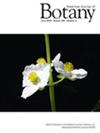The self-replicating cellular organization of shoot apical meristems
Abstract
Premise
Apical meristems of land plants have played a fundamental role in the evolution of complex shoot architectures. The most common structure of shoot apical meristems in bryophytes, lycophytes, and ferns is characterized by a single apical cell surrounded by a spiral of apical derivatives. Despite the importance of this type of meristem organization, it remains unclear how it is maintained at the apex.
Methods
We analyzed the distribution of different meristem organizations within a data set of 205 images of shoot apical meristems representing 91 species of bryophytes, lycophytes, and ferns. In parallel, we developed a mathematical and computational model to determine whether the meristem structural types observed empirically are predicted from Sachs's division rules; namely, cells divide symmetrically while positioning their new wall at a right angle to the parental walls.
Results
According to our data set, only four meristem structural types are observed in nature, corresponding to apical cells dividing along one, two, three, or four faces. In addition, the prevalence of the structural types in diverse plant lineages correlates with the shape of the meristems on which they are found. Our model based on Sachs's division rules indicates that as much as six meristem structural types are geometrically possible, but only the four types observed empirically are dynamically stable for realistic meristem geometries.
Conclusions
Simple division rules, which we interpret as biophysical constraints on the assembly of the preprophase band, may therefore explain the cellular organization of the shoot apical meristem in three major groups of land plants.



 求助内容:
求助内容: 应助结果提醒方式:
应助结果提醒方式:


